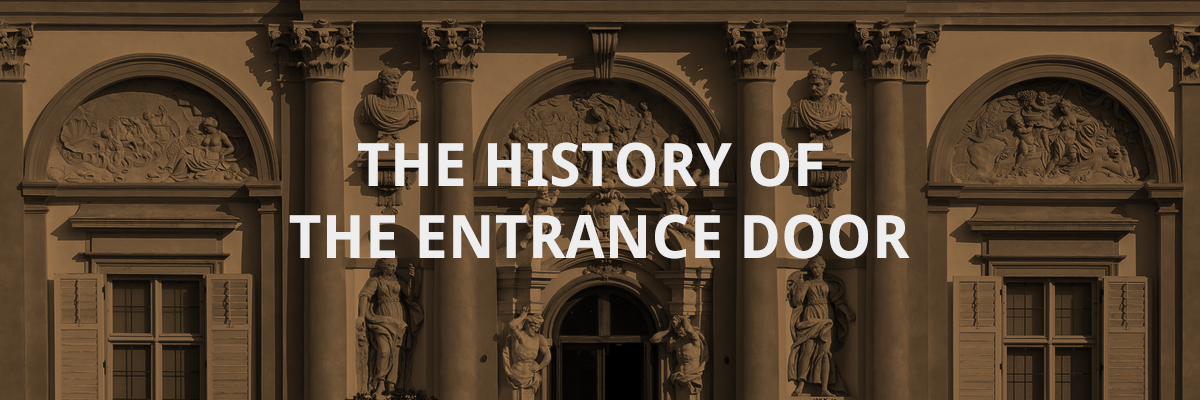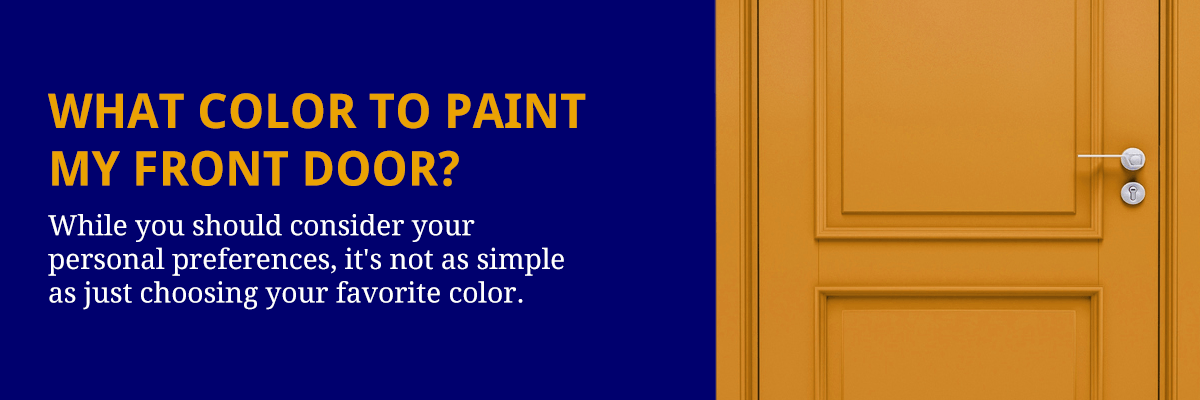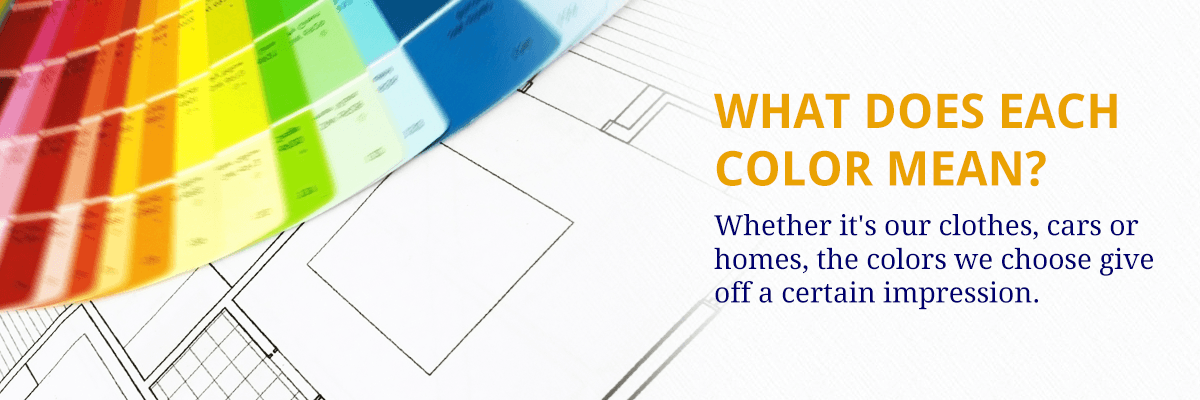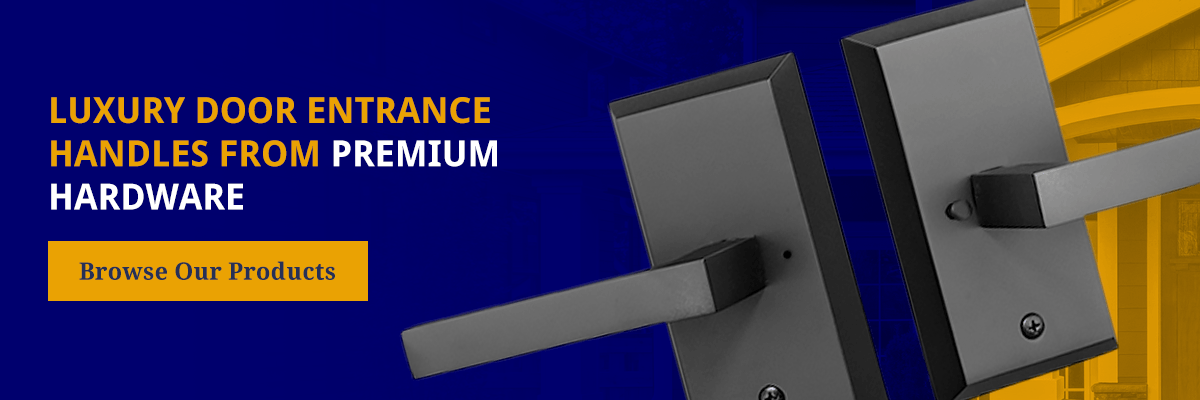What Your Entrance Door Color Says To Your Guests
07/28/2021, 1:47 PM

Chances are that your home has a front door. While homes without windows are seen on occasion, homes without front doors are practically unheard of. And there’s a good reason for this — they keep you warm, protect you from intruders and serve as the focal point of your home’s exterior.
It’s important to give much consideration to the color of your front door. Not only is it an excellent opportunity to express your personality and values, but it can also strongly affect the moods of all who enter your home.
You can choose from a wide variety of door styles and colors, many of which became popular during a certain period of history. We’ll start with the history of the front door, then cover color schemes and the meanings of different colors.
The History of the Entrance Door
Doors are thought to have first emerged in ancient Egypt when they existed as simple wood slabs with hinges. In early India, doors were made from stone and opened and closed like saloon doors. And in ancient Rome and Greece, historical artifacts suggest that doors were made of bronze and featured many different styles such as single, double and sliding.
In the West, front doors have taken on a variety of forms. Below are the most notable characteristics of each era:
1. Tudor
Most popular from 1485 to 1625, Tudor doors were designed to serve one of two purposes — prevent intruders from entering or to impress guests. These doors tended to be made of oak and feature elaborate engravings. This door style remains popular today.
2. Baroque
The Baroque period, which lasted from 1625 to 1714, is well known for its extravagant architecture — and doors were no exception. Baroque doors featured intricately carved brackets and sometimes even pillars.
3. Early Georgian
Immediately following the Baroque era and lasting until 1765, the early Georgian era featured plain, paneled doors that were painted dark colors or grained. Internal doors, which were carved or paneled, also gained popularity. In grander homes, the main doors were typically double doors that featured elaborate door handles and bell rings.
4. Late Georgian
Spanning from 1765 until 1811, doors of the late Georgian period retained the elaborate wood workings of the previous era but became smaller due to the emergence of the fanlight. Fanlights were simple and rectangular at first, but later become segmental or semi-circular. Doors found in grand homes were typically made of oak or mahogany and featured six panels.
5. Late Georgian Regency and Early 19th Century
In this period, which lasted from 1811 to 1837, door designs became more diverse and inventive, including ones with reeded carved molding, geometric paneling and studs evocative of ancient Greece.
6. British Victorian
The British Victorian period spanned from 1837 until 1901, and its front doors typically were dark green and contained four panels with two window panes near the top. Later on, these windows took on their trademark look, being made of either stained or etched glass.
Starting in the 1840s, letterboxes were introduced into front doors, which would let in cold air during the cold winters, prompting Victorians to add front door curtains.
7. Edwardian
Following the British Victorian period was the brief Edwardian era, which lasted until 1914. Front doors from this era paid homage to the art nouveau style. They were constructed from softwood and came in a variety of contrasting, vibrant colors. During this time, some doors began to feature electric doorbells, although door knockers remained common.
8. The Modern Movement
The modern movement is a period from roughly 1920 to 1950, and doors of this era were characterized by simplicity. Doors were constructed more economically by using many layers of softwood, which possessed the strength of hardwood.
9. Beyond Modern
Lasting from 1950 until 1975, the most salient characteristic of this era was the eradication of interior doors. The concept of doorways without doors made homes feel more open and quickly became popular. Other characteristics of this era were strong colors and sliding doors.
What Color to Paint My Front Door?
Color is an effective way to convey a broad range of impressions and emotions. When it comes to something as impactful as your front door, you should take plenty of time to consider the hue that works best. But the question remains — how do you go about picking that perfect color?
While you should consider your personal preferences, it’s not as simple as just choosing your favorite color. While there are no strict rules when it comes to mixing and matching hues, we believe the following three considerations will help you narrow down your options:
1. Your Home’s Style
The style and colors of your home’s exterior serve as a good guide when it comes to choosing the right front door color. Most home styles correspond to a certain color palette. For instance, homes in the classic style tend to be elegant and timeless, so a white front door tends to work best.
A traditional home tends to feature a rich palette of colors, so in this case, it’s often best to go with a dark brown door. Cottage home designs, on the other hand, are often inspired by nature, which is why greens or light blues tend to go well. Modern homes usually feature minimalist color palettes, so doors with red or lime green colors are great for giving them a pop of color.
The front door that you choose should ideally harmonize with your home’s style and the surrounding environment as well. While it is not common to match your front door color with that of your garage, picking a complementary color often lends beautiful results.
2. Your Personality
Your house should reflect who you are, and choosing the color of your front door is a way to express your individuality and creativity. It is also thought that the shade you choose reflects your character and your type of home.
3. The Color Wheel
When choosing the best front door color, it’s important to familiarize yourself with the fundamental principles of color. The color wheel is a useful, easy-to-use tool that designers consult to create attractive color palettes. There are several color schemes based on the color wheel that you can choose, the most common being complementary, analogous, monochromatic and neutral:
- Complementary color scheme: This scheme features colors that are on opposite sides of the color wheel. Some examples include yellow and purple, blue and orange and red and green. Complementary colors are a good choice if you want an energetic feel for the exterior of your home. For instance, if you own a red brick home, an olive green front door can provide a pop of color, and a yellow cottage will look more attractive with a purple front door.
- Analogous color scheme:Analogous color combinations are adjacent on the color wheel. One example is blue-green, green and yellow-green. Whereas complementary colors grab your attention, analogous color combinations look more subdued and harmonious. A red brick house, for instance, will look particularly warm and inviting with a reddish-violet front door.
- Monochromatic color scheme: A monochromatic color scheme consists of various shades of a single hue, and is used to give visual interest and a sense of depth. If you want your home’s exterior to look more expansive, this color scheme is what you’re looking for. A white home, for example, will look considerably bigger with a cream front door.
- Neutral color scheme: This color scheme consists of black, white, gray and browns and is ideal for those who want their homes to look timeless. A home with a white front door and brown brick exterior is a good example of this.
What Does Each Color Mean?
Whether it’s our clothes, cars or homes, the colors we choose give off a certain impression. Below we’ll discuss how each color impacts viewers:
1. Red
This color provides a powerful punch to your home. Not only does it make a bold statement — it will likely make your home stand out in your neighborhood.
Generally speaking, doors painted red tend to convey hospitality and make guests feel welcome. Red doors also express a passionate, full-of-life attitude. According to the principles of feng shui, this color represents good fortune and positive energy. In American folklore, a red door indicated a safe house on the Underground Railroad, and in Scotland, a red door often means that the owners have paid the home’s mortgage.
There are a variety of red shades that work well for front doors. While fire engine red is vibrant and merlot is captivating, other shades, such as burgundy, are a great choice if you want your door to look interesting but not too intense.
2. Blue
Several studies suggest that blue is the most popular front door color. This color is thought to convey wealth, royalty and also fun. As it is the color of water and is associated with the heavens, it also symbolizes cleansing. Homes with blue front doors give the impression of being peaceful and relaxing.
People who choose blue front doors tend to be easygoing and attract others. As this color is also associated with imagination and inspiration, it’s also an appropriate color for artists.
3. Light Blue
If you want your home to express a beachy, inviting and relaxed feel, a light blue front door is ideal.This color conveys peace and serenity, and homes with this front door color are thought to be a getaway from a busy, hectic world.
4. Navy Blue
Navy blue is a timeless color and goes well with practically any decor. It works particularly well with a light blue or gray house. It also conveys a vintage feel and is popular because it appears to change color during different times of the day.
Navy blue conveys stability and safety and, like other shades of blue, it makes guests feel more calm and relaxed. If you think of your home as a sanctuary, consider painting your door navy blue to reflect that. According to feng shui, navy blue is also a symbol of abundance.
5. Yellow
If you want to uplift the spirits of your family and guests, this cheerful vibe is an ideal choice, as many people think of it as a “happy color.” It reflects more light than most other colors, which means it can instantly light up a space. It’s a great way to revive an otherwise dull facade.
This color conveys mental clarity, confidence, optimism, and wisdom, and those with yellow doors are often thought to be leaders and people-pleasers.
6. Black
Black is thought to symbolize power, strength and authority. It grabs your attention and can produce strong feelings. Homeowners with black front doors are often perceived to be conservative, reserved and consistent.
One of the significant advantages of black front doors is their timelessness. Regardless of current trends, your black door will never look dated. A simple black door looks elegant and sophisticated and often conveys a sense of mystery. Black doors are also a plus when selling your home, as the color communicates potential and possibility.
7. Pink
Pink is the ultimate romantic color. It’s associated with happiness and conveys a fun, exciting feel. It is also a symbol of youthfulness and courage. If you have a pink front door, you will likely be perceived as thoughtful, cheerful and kind. This color goes particularly well with cottages and brick homes.
8. Teal
This color is a perfect choice if you want something that is traditional but not boring. It is often thought to symbolize creativity and can help with emotional healing. It goes well with nearly any design, whether it’s a formal and historical or eclectic and quirky. This hue is also suitable for homes with white exteriors or full wooden sidings. Like blue, teal is a color that makes people feel calm.
9. Orange
Orange is considered the color of extroverts, as it is associated with friendliness, sociability and fun. This energetic color combines the happiness of the color yellow and the excitement of the color red.
If you want to make a bold statement with your front door, this show-stopping hue may be the best option for you. It both grabs people’s attention and makes them feel welcome.
10. White
White is perhaps most commonly associated with purity and cleanliness, but it can also convey calm and peacefulness and represent a new start. According to feng shui principles, white symbolizes neutrality.
White is also thought to be an extremely versatile color for design. Although typically seen in classic, formal exteriors, white doors work well with exteriors of any color or design. You can use it to brighten up darker exteriors, and it even goes well with all-white facades.
11. Purple
Commonly associated with royalty, purple symbolizes wealth, loyalty and honor. It combines red’s stimulating energy and blue’s sense of serenity.
Purple is perhaps the least popular color choice for a home’s facade, but it does make homes feel regal and welcoming. People with purple front doors are often thought to be artistic and free-spirited. It is considered a particular versatile color in feng shui, as it is the only hue that can be used regardless of the direction the door faces.
12. Green
This color is universally associated with nature and symbolizes growth and freshness. It’s also associated with balance and harmony, and a front door painted green suggests its inhabitants care about the community. You can use this color to tie together the natural elements outside with the safe interior.
Check out the Luxury Door Entrance Handles From Premium Hardware
When you have a magnificent front door, you need impressive hardware to match. At Premium Hardware, we can provide you with an elegant handle to complement your elegant front door. Our luxury handles are designed to be safe, secure and sturdy.
Because our company designs many of our products, we are very knowledgeable about our door handles, so feel free to ask us any questions by calling us at 510-296-5584. You can also contact us via our online form or browse our diverse product selection on our site.




